入到PSO。此外,还有其它一些混合PSO:
高斯PSO:由于传统PSO往往是在全局和局部最佳位置的中间进行搜索,搜索能力和收敛性能严重依赖加速常数
和惯性权值的设置,为了克服该不足,Secrest等人[90]将高斯函数引入PSO算法中,用于引导粒子的运动;GPSO不再
需要惯性权值,而加速常数由服从高斯分布的随机数产生。
拉伸PSO(Stretching PSO, SPSO):SPSO将所谓的拉伸技术(stretching technique)[91]以及偏转(deflection)和排斥
(repulsion)技术应用到PSO中,对目标函数进行变换,限制粒子向已经发现的局部最小解运动,从而利于粒子有更多
的机会找到全局最优解[4, 92]。
混沌粒子群优化:混沌是自然界一种看似杂乱、其实暗含内在规律性的常见非线性现象,具有随机性、遍历性
和规律性特点。文献[93]利用混沌运动的遍历性以粒子群的历史最佳位置为基础产生混沌序列,并将此序列中的最优
位置随机替代粒子群中的某个粒子的位置,提出混沌PSO(chaos particle swarm optimization, CPSO)。除此之外,文献
[94]利用惯性权值自适应于目标函数值的自适应PSO进行全局搜索、利用混沌局部搜索对最佳位置进行局部搜索,提
出一种PSO与混沌搜索相结合的混沌PSO;文献[15]则利用混沌序列确定PSO的参数(惯性权值和加速常数);文献[95]
提出一种不含随机参数、基于确定性混沌Hopfield神经网络群的粒子群模型。
免疫粒子群优化:生物免疫系统是一个高度鲁棒性、分布性、自适应性并具有强大识别能力、学习和记忆能力
的非线性系统。文献[96]将免疫系统的免疫信息处理机制(抗体多样性、免疫记忆、免疫自我调节等)引入到PSO中,
分别提出了基于疫苗接种的免疫PSO和基于免疫记忆的免疫PSO。
量子粒子群优化:文献[97]采用量子个体提出离散PSO;文献[98]则基于量子行为更新粒子位置。
卡尔曼PSO:文献[99]利用Kalman滤波更新粒子位置。
主成分 PSO:文献[100]结合主成分分析技术,粒子不仅按照传统算法在 n 维的 x 空间飞行,而且还在 m 维的 z
空间同步飞行(m
更为重要的是,比较全面地列出了在国际主要期刊和会议上发表的论文目录以及很多PSO及其改进算法的源
代码,如基于MATLAB的PSO工具箱、2006 年版和 2007 年版的标准PSO(Standard PSO 2006/2007)、无须
人为设定参数的PSO-TRIBES等等。
6 结论与展望
粒子群优化(PSO)是一种新兴的基于群体智能的启发式全局随机搜索算法,具有易理解、易实现、全局搜索能力
强等特点,为各个领域的研究人员提供了一种有效的全局优化技术。本文对PSO的基本原理、改进形式与应用领域
等方面进行了全面综述。在科学与工程实践领域,关心PSO的读者的共同兴趣所在是PSO本身,即“PSO是什么”和“有
些什么样的改进形式”,而“用PSO怎样解决某个具体问题”则依赖于相应领域的专业知识;为了让尽可能多的国内读
者从中受益而不局限于具体的工业背景,综述内容侧重于对基本PSO原理、算法改进,特别是相关国际发展现状进
行分析,而PSO应用综述仅仅列出了典型理论问题和实际工业问题两个方面的一些主要应用对象。文中同时给出了
三个重要的获取PSO文献和源程序的网站。
总之,本文给出了 PSO 的基本原理,让初学者轻松入门;给出了国内外具有重要影响的各种改进形式,不仅
可以让初学者得到提高的机会,也让资深读者从中受到启发;给出了获取 PSO 文献和源程序的网址,让广大读者、
特别是初学者能“拿来就用”,事半功倍。
由于 PSO 毕竟是一种新兴的智能优化算法,在以下方面仍然值得进一步研究:
(1) 理论研究:虽然目前对PSO稳定性和收敛性的证明已取得了一些初步成果[52, 126-129],但自诞生以来其数学
基础一直不完备,特别是收敛性一直没有得到彻底解决。因此,仍需要对PSO的收敛性等方面进行进一步
的理论研究。
(2) 控制参数自适应:虽然对PSO参数的改进策略等方面已取得了一定进展,但仍然有很大的研究空间;特别
是如何通过对参数自适应调节以实现“探索(exploration)”与“开发(exploitation)”之间的平衡[130]、以及“nearer
is better” 假设与“nearer is worse”假设之间的智能转换[
]131 ,是一个令人很感兴趣的课题。
(3) 信息共享机制:基于邻域拓扑的 PSO 局部模型大大提高了算法全局搜索能力,充分利用或改进现有拓扑结
构以及提出新的拓扑,进一步改善算法性能,是一个值得进一步研究的问题。同时,由于全局模型具有较
快的收敛速度、而局部模型具有较好的全局搜索能力,对信息共享机制做进一步研究,保证算法既具有较
快的收敛速度、又具有较好的全局搜索能力,也是一个很有意义的研究方向。
(4) 混合PSO:混合进化算法是进化算法领域的趋势之一[132],与其它进化算法或传统优化技术相结合,提出新
的混合PSO算法,甚至提出基于PSO的超启发式搜索算法(hyper-heuristics),使算法对不同种类的问题具有
尽可能好的普适性,并能“更好、更快、更廉(good enough – soon enough – cheap enough)”地得到问题的解[133],
也是一个很有价值的研究方向。
(5) 应用研究:算法的有效性和价值必须在实际应用中才能得到充分体现。广大科学与工程领域的研究人员,
在各自的专业背景下,利用 PSO 解决各种复杂系统的优化问题,进一步拓展其应用领域,是一项十分有意
义的工作。此外,由于 PSO 本质上是一种随机搜索算法,现场工程技术人员对它的可靠性仍难免心存疑虑,
将 PSO(或与工业系统在役技术结合)进行实用化推广,仍是一项任重而道远的任务。
参考文献:
[1] Kennedy J, Eberhart R. Particle swarm optimization [A]. in: Proceedings of the 4th IEEE International Conference on Neural Networks
[C],Piscataway: IEEE Service Center, 1995, pp.1942 -1948.
[2] Simon Garnier, Jacques Gautrais, Guy Theraulaz. The biological principles of swarm intelligence [J]. Swarm Intelligence, no.1, pp.3-31,
2007.
[3] R. Eberhart and Y. Shi. Particle swarm optimization: Developments, applications and resources [A]. in Proc. IEEE Congr. Evol. Comput.
[C], vol.1, pp.81-86, May 2001.
[4] K. Parsopoulos and M. Vrahatis, Recent approaches to global optimization problems through particle swarm optimization [J]. Natural
Computing, vol.1, pp.235-306, May 2002.
[5] 谢晓锋,张文俊,杨之廉. 微粒群算法综述[J]. 控制与决策, 2003,18(2): 129-134.
[6] X. Hu, Y. Shi, and R. Eberhart. Recent advances in particle swarm [A]. in Proc. IEEE Congr. Evol. Comput.[C], vol.1, pp.90-97, Jun.
2004.
[7] Alec Banks, Jonathan Vincent, Chukwudi Anyakoha. A review of particle swarm optimization. Part I: background and development [J].
Natural Computing, no.6, pp.467-484, 2007. Part II: hybridization, combinatorial, multicriteria and constrained optimization, and
�
indicative applications [J]. Natural Computing, no.7, pp.1-16, 2007.
[8] 王万良,唐宇. 微粒群算法的研究现状与展望 [J]. 浙江工业大学学报, 2007, 35(2): 136-141.
[9] Riccardo Poli, James Kennedy and Tim Blackwell. Particle swarm optimization: An overview [J]. Swarm Intelligence, vol.1, no.1,
pp.33-57, 2007.
[10] Jelmer van Ast, Robert Babuška and Bart De Schutter. Particle swarms in optimization and control [A]. in Proceedings of the 17th World
Congress The International Federation of Automatic Control [C]. Seoul, Korea, pp.5131-5136, July 6-11, 2008.
[11] J. Kennedy, The particle swarm: Social adaptation of knowledge [A]. in Proc. IEEE Int. Conf. Evol. Comput. [C], Apr. 1997, pp. 303–308.
[12] W. B. Langdon and Riccardo Poli. Evolving problems to learn about particle swarm and other optimizers [A], in Proc. CEC-2005 [C],
vol.1, pp.81-88, 2005.
[13] M. Clerc. Stagnation analysis
in particle swarm optimization or what happens when nothing happens. Online at
http://clerc.maurice.free.fr/pso/.
[14] S. H. Ling, H. H. C. Iu, F. H. F. Leung, et al. Improved hybrid particle swarm optimized wavelet neural network for modeling the
development of fluid dispensing for electronic packaging [J]. IEEE Trans. Ind. Electron., ol.55, no.9, pp.3447-3460, 2008.
[15] L. dos Santos Coelho, B.M. Herrera. Fuzzy identification based on a chaotic particle swarm optimization approach applied to a nonlinear
yo-yo motion system [J]. IEEE Trans. Ind. Electron., vol.54, no.6, pp.3234-3245, 2007.
[16] Maurice Clerc. Initialisations for particle swarm optimization. Online at http://clerc.maurice.free.fr/pso/, 2008.
[17] M. Richards and D. Ventura. Choosing a starting configuration for particle swarm optimization [A]. in Proc. IEEE Int. Joint. Conf. Neural
Netw. [C], Jul. 2004, vol. 3, pp. 2309–2312.
[18] 薛明志,左秀会,钟伟才 等. 正交微粒群算法 [J]. 系统仿真学报, 2005, 17(12): 2908-2911.
[19] E. F. Campana, G. Fasano, and A. Pinto. Dynamic system analysis and initial particles position in particle swarm optimization [A]. in
Proc.IEEE Swarm Intell. Symp. [C], May 2006, pp. 202–209.
[20] R. Eberhart, Y. Shi, and J. Kennedy, Swarm Intelligence [M]. San Mateo, CA: Morgan Kaufmann, 2001.
[21] J. Kennedy. Small worlds and mega-minds: Effects of neighborhood topology on particle swarm performance [A]. in Proc. IEEE Congr.
Evol. Comput. [C], Jul. 1999, vol. 3, pp. 1931–1938.
[22] J. Kennedy and R. Mendes. Population structure and particle swarm performance [A]. in Proc. IEEE Congr. Evol. Comput. [C], May 2002,
vol. 2, pp. 1671–1676.
[23] Suganthan, P.N. Particle swarm optimiser with neighbourhood operator [A]. in Proceedings of the IEEE Congress on Evolutionary
Computation (CEC) [C], Piscataway, NJ, 1999, 1958-1962
[24] K. Veeramachaneni, T. Peram, C. Mohan, and L. A. Osadciw, Optimization using particle swarms with near neighbor interactions [A]. in
Proc. Genetic and Evolutionary Computation (GECCO 2003) [C], vol. 2723, 2003, pp. 110–121.
[25] A. Abraham, H. Guo, and H. Liu. Swarm intelligence: foundations, perspectives and applications [A]. Swarm Intelligent Systems, Studies
in Computational Intelligence [C], N. Nedjah, L. Mourelle (eds.), Springer Verlag, pp.3-25, 2006.
[26] M. Clerc. Back to random topology. Online at http://clerc.maurice.free.fr/pso/, 2007.
[27] Standard PSO 2006/2007 (SPSO-06/SPSO-07) on the Particle Swarm Central, Programs section: http://www.particleswarm.info.
[28] Mark Richards and Dan Ventura, Dynamic sociometry in particle swarm optimization [A]. International Conference on Computational
Intelligence and Natural Computing [C], pp. 1557-1560, September 2003.
[29] Løvbjerg M,Rasmussen T K,Krink T.Hybrid Particle Swarm Optimizer with Breeding and Subpopulations [A].In:Proc. of the 3rd
Genetic and Evolutionary Computation Conference [C].San Francisco,USA: Morgan Kaufmann,2001, pp.273-280.
[30] J. Kennedy, Stereotyping: Improving particle swarm performance with cluster analysis [A]. in Proc. 2000 Congr. Evolutionary Computing
[C], 2000, pp. 1507–1512.
[31] X. Li. Adaptively choosing neighborhood bests using species in a particle swarm optimizer for multimodal function optimization [A]. in
Proc.Genetic Evol. Comput. Conf. [C], Jun. 2004, pp. 105–116.
[32] Stefan Janson and Martin Middendorf. A hierarchical particle swarm optimizer and its adaptive variant [J]. IEEE Transactions on Systems,
Man, and Cybernetics-Part B: Cybernetics, 2005, vol.35, no.6, pp. 1272-1282.
[33] Ben Niu, Yunlong Zhu, Xiaoxian He et al. A multi-swarm optimizer based fuzzy modeling approach for dynamic systems processing [J].
Neurocomputing, 2007, pp. 1-13.
[34] R.Brits, A.P. Engelbrecht, F. van den Bergh. A Niching Particle Swarm Optimizer [A]. in Proceedings of the 4th Asia-Pacific Conference
on Simulated Evolution and Learning [C], Singapore: Orchid Country Club, pp.692-696, 2002.
�
[35] T. M. Blackwell and J. Branke, Multi-swarm optimization in dynamic environments [A]. LNCS No. 3005: Proceedings of Applications of
Evolutionary Computing: EvoWorkshops [C], Coimbra, Portugal. pp. 489-500, 2004.
[36] J. J. Liang and P. N. Suganthan. Dynamic Multi-Swarm Particle Swarm Optimizer [A]. IEEE International Swarm Intelligence Symposium
[C], 2005, pp.124-129.
[37] J. Kennedy and R. Mendes. Neighborhood topologies in fully-informed and best-of-neighborhood particle swarms [A]. in Proc. IEEE Int.
Workshop Soft Computing in Industrial Applications [C], Jun. 2003, pp.45–50.
[38] F. Bergh and A. Engelbrecht, A cooperative approach to particle swarm optimization [J]. IEEE Trans. Evol. Comput., vol. 8, no. 3,
pp.225–239, Jun. 2004.
[39] S. Baskar and P. N. Suganthan. A novel concurrent particle swarm optimization [A], in Proc. IEEE Congr. Evol. Comput. [C], Jun. 2004,
vol. 1, pp. 792–796.
[40] M. El-Abd and M. S. Kamel, A hierarchal cooperative particle swarm optimizer [A]. in Proc. IEEE Swarm Intell. Symp. [C], May 2006,
pp. 43–47.
[41] J. J. Liang, A.K. Qin, Ponnuthurai Nagaratnam Suganthan, et al. Comprehensive learning particle swarm optimizer for global optimization
of multimodal functions [J]. IEEE Transaction on Evolutionary Computation, 2006, 10(3): 67-82.
[42] T.M.Blackwell, P. J. Bentley. Don’t push me! Collision-avoiding swarms [A]. in Proc. IEEE Congr. Evol. Comput. [C], May 2002, vol. 2,
pp.1691–1696.
[43] T. M. Blackwell and P. J. Bentley, Dynamic search with charged swarms [A]. in Proc. Genetic Evol. Comput. Conf. [C], W. B. Langdon et
al., Eds., 2002, pp. 19–26.
[44] M. Løvbjerg and T. Krink. Extending particle swarms with self-organized criticality [A]. in Proc. IEEE Congr. Evol. Comput. [C],May
2002, vol.2, pp. 1588–1593.
[45] Thiemo Krink, Jakob S. Vesterstrøm, Jacques Riget. Particle swarm optimization with spatial particle extension [A]. in: Proceedings of the
2002 Congress on Evolutionary Computation [C], 2002, vol.2,pp.1474-1479.
[46] Y. del Valle, G. Venayagamoorthy, S. Mohagheghi, et al. Particle Swarm Optimization: Basic Concepts, Variants and Applications in
Power Systems [J]. IEEE Transactions on Evolutionary Computation, vol.12, no.2, pp.171-195, 2008.
[47] H. Fan and Y. Shi, Study on Vmax of particle swarm optimization [A]. in Proc. Workshop on Particle Swarm Optimization, Purdue School
of Engineering and Technology [C], Indianapolis, IN, Apr. 2001.
[48] A. Abido, Optimal power flow using particle swarm optimization [J]. Int. J. Elect. Power Energy Syst., vol. 24, no. 7, pp. 563–571, Oct.
2002.
[49] E. Ozcan and C. Mohan, Particle swarm optimization: Surfing the waves [A]. in Proc. IEEE Congress Evol. Comput. [C], Jul. 1999, vol. 3,
pp.1939–1944.
[50] Ratnaweera A, Halgamuge SK, and Watson HC. Self-Organizing Hierarchical Particle Swarm Optimizer with Time-Varying Acceleration
Coefficients [J]. IEEE Transactions on Evolutionary Computation, 8(3), 240–255, 2004.
[51] Jacques Riget and Jakob S. Vesterstrøm. A diversity-guided particle swarm optimizer-the ARPSO. EVALife Technical Report, no.
2002-02.
[52] M. Clerc and J. Kennedy. The particle swarm - explosion, stability, and convergence in a multidimensional complex space [J]. IEEE
Transactions on Evolutionary Computation, 6(1):58–73, February 2002.
[53] Y. Shi and R. Eberhart, A modified particle swarm optimizer [A]. in Proc. IEEE World Congr. Comput. Intell. [C], May 1998, pp. 69–73.
[54] Y. Shi and R. Eberhart, Empirical study of particle swarm optimization [A]. in Proc. IEEE Congr. Evol. Comput. [C], Jul. 1999, vol. 3,
pp.1945–1950.
[55] X. Chen and Y. Li, An improved stochastic PSO with high exploration ability [A]. in Proc. IEEE Swarm Intell. Symp. [C], May 2006,
pp.228–235.
[56] R. Eberhart and Y. Shi, Comparing inertia weights and constriction factors in particle swarm optimization [A]. in Proc. IEEE Congress
Evol. Comput. [C], Jul. 2000, vol. 1, pp. 84–88.
[57] S. Mohagheghi, Y. Del Valle, G. Venayagamoorthy, and R. Harley, A comparison of PSO and backpropagation for training RBF neural
networks for identification of a power system with STATCOM [A]. in Proc. IEEE Swarm Intell. Symp. [C], Jun. 2005, pp. 381–384.
[58] Y. Shi and R. Eberhart, Fuzzy adaptive particle swarm optimization [A]. in Proc. IEEE Congr. Evol. Comput. [C], May 2001, vol. 1, pp.
101–106.
[59] Y. Shi and R. Eberhart, Particle swarm optimization with fuzzy adaptive inertia weight [A]. in Proc. Workshop on Particle Swarm
�
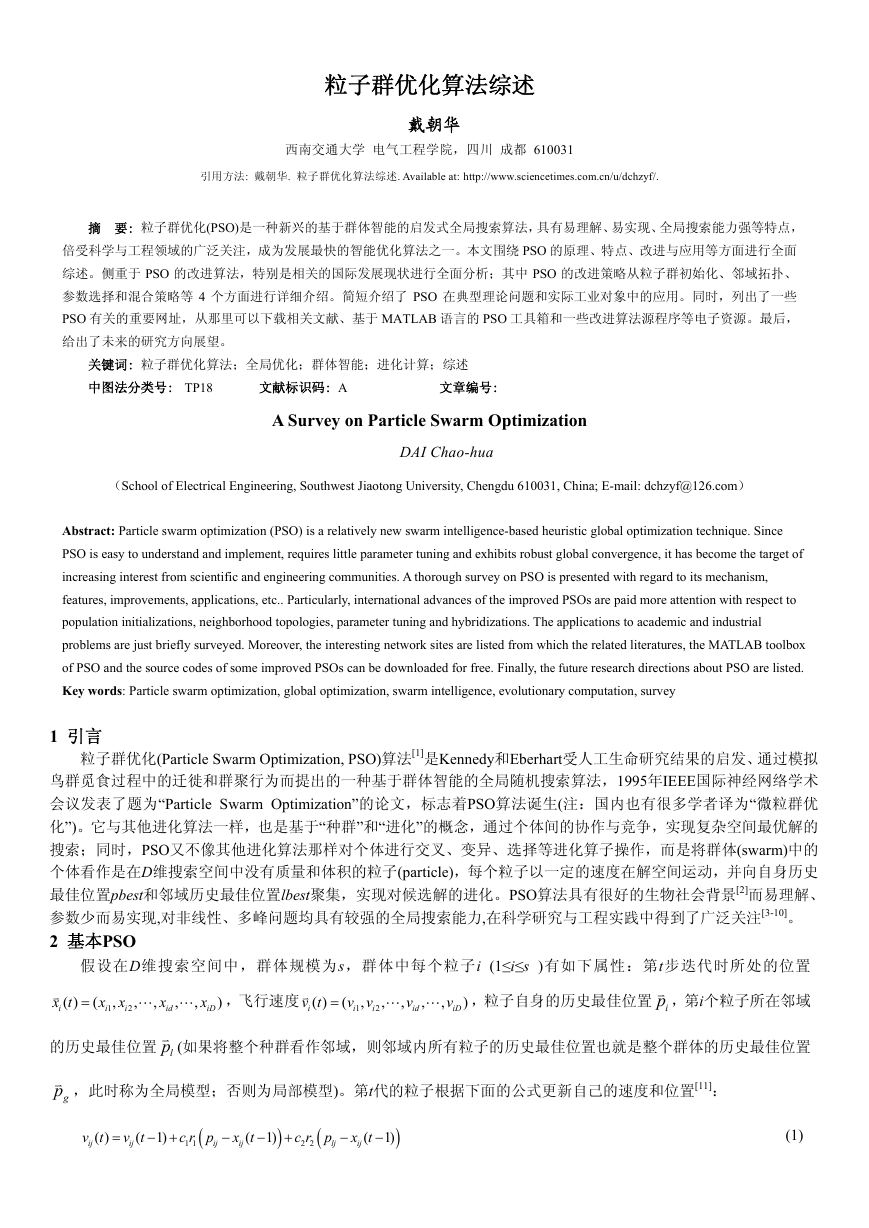
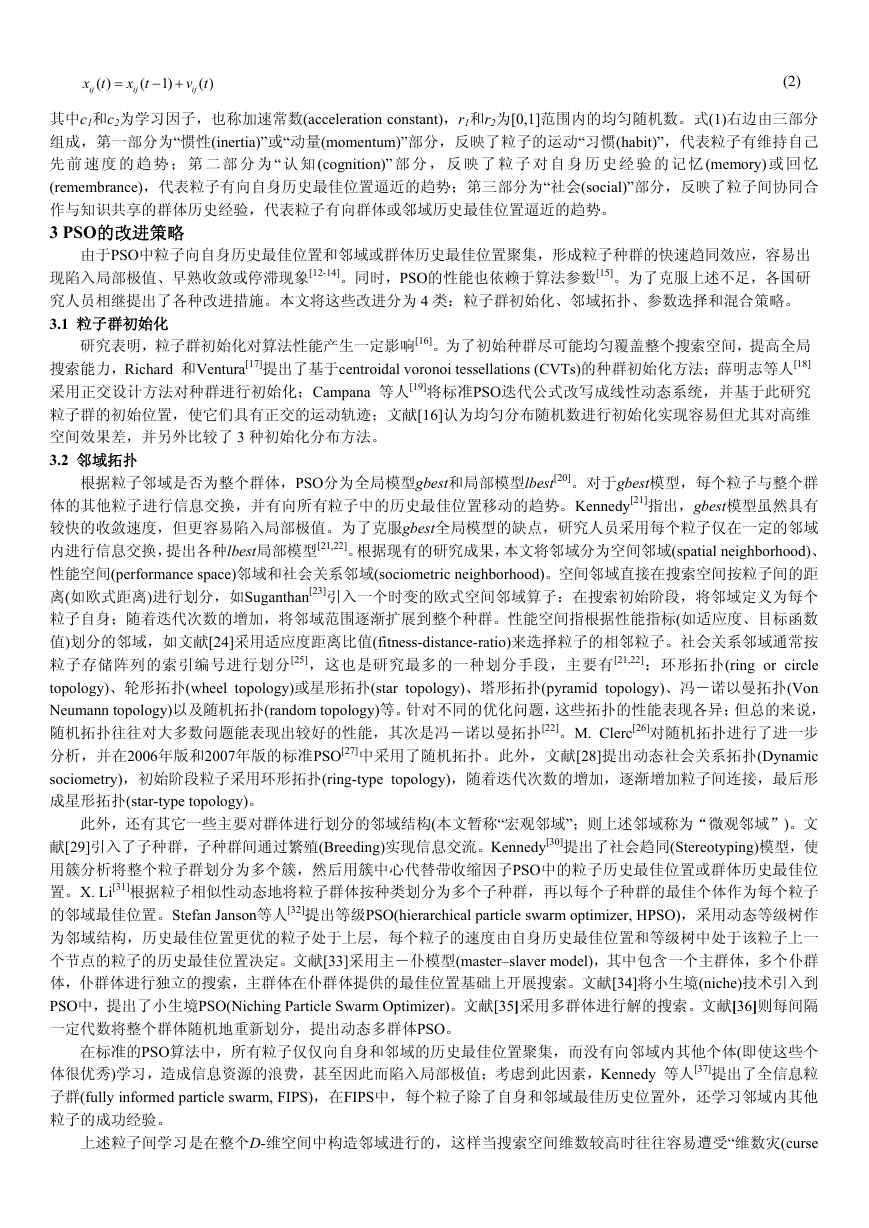

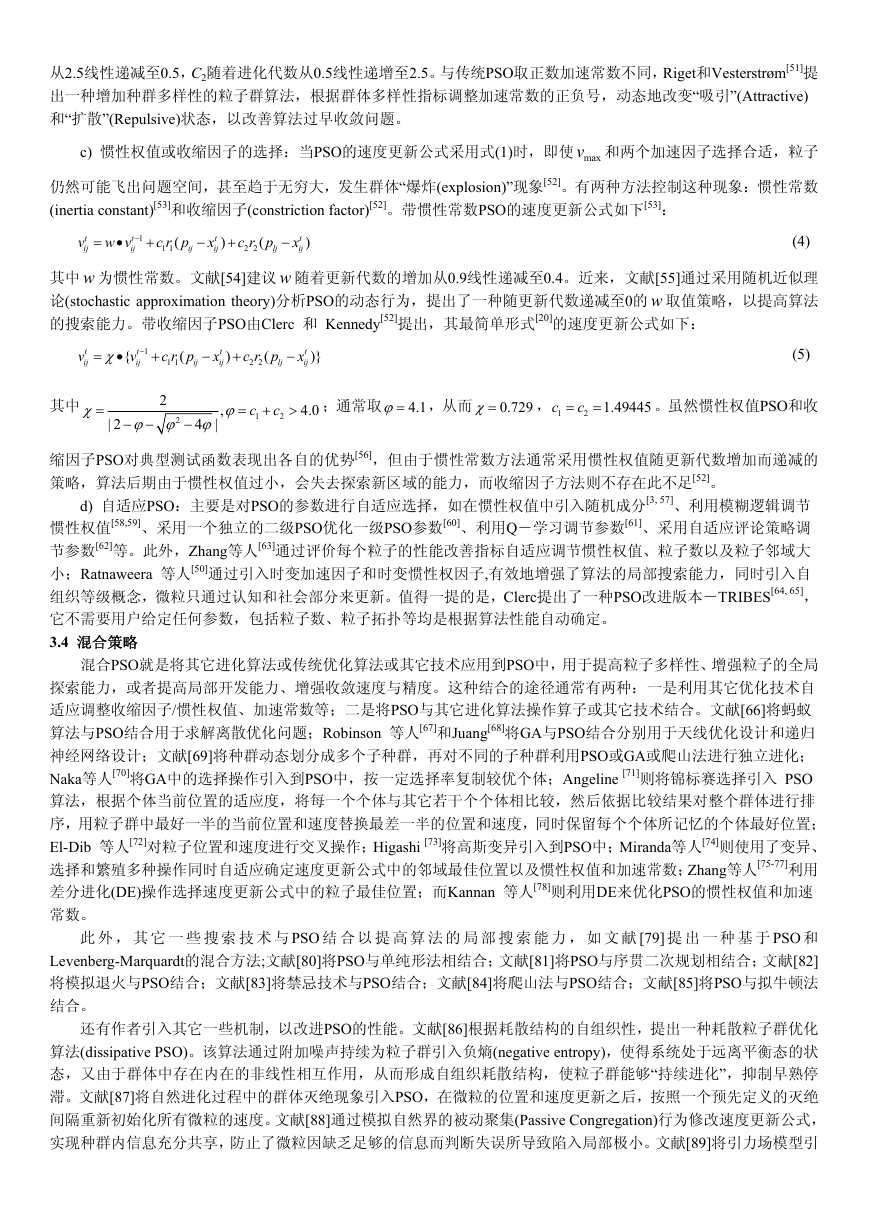
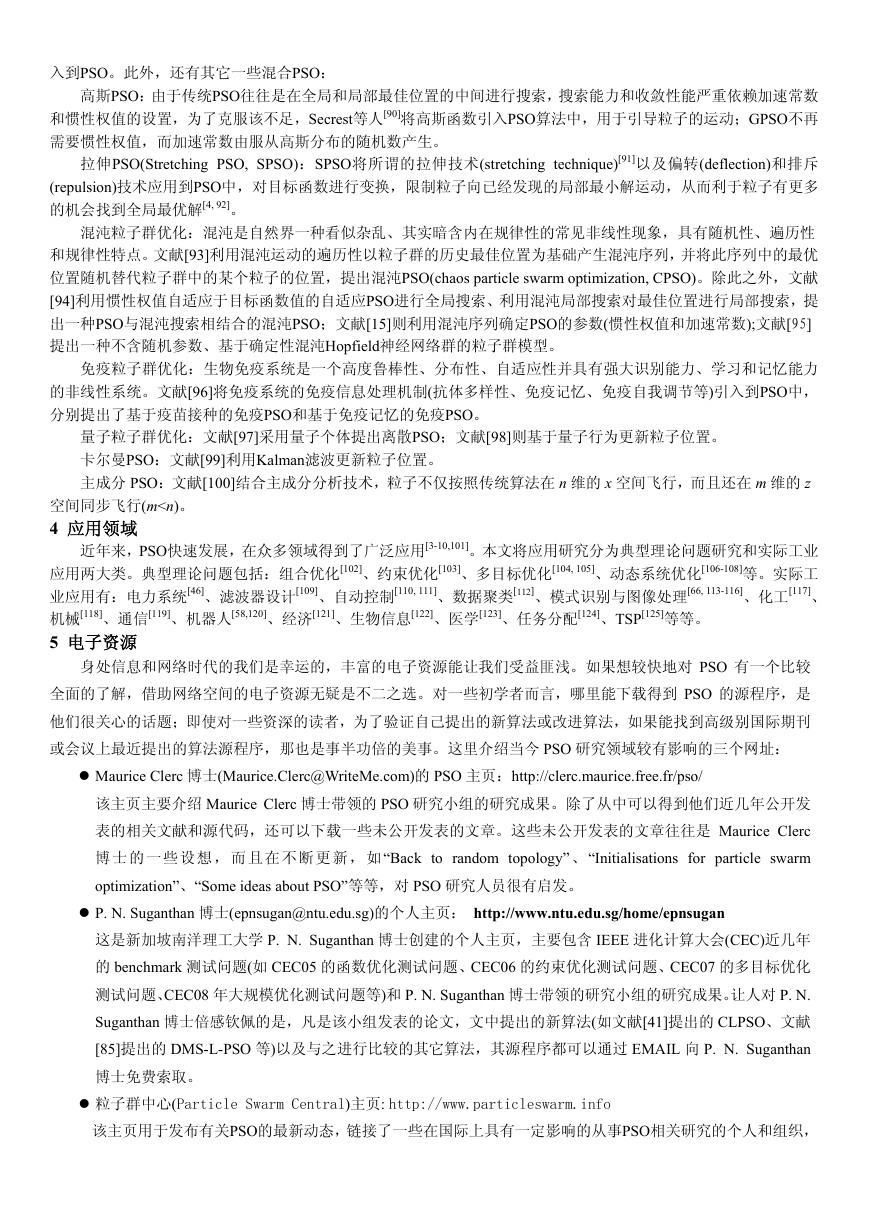
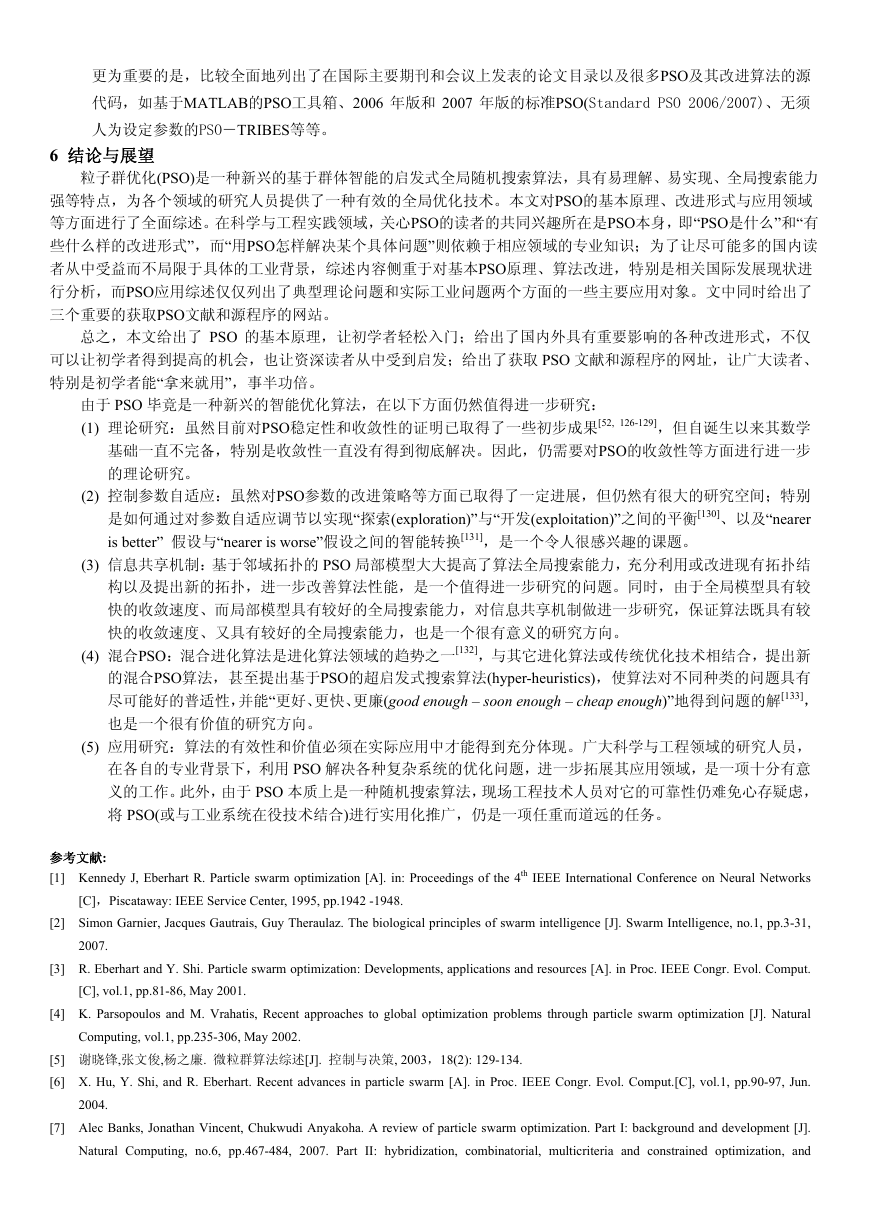
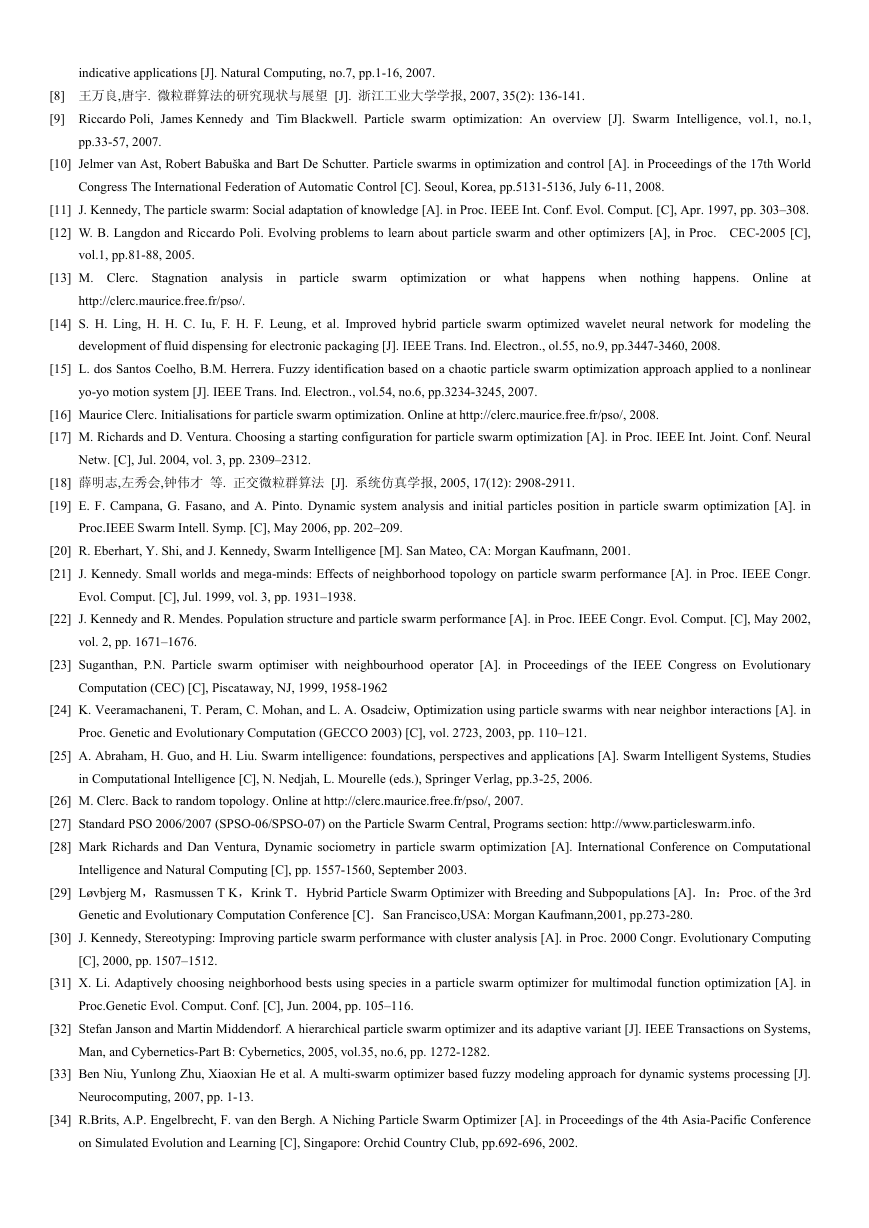
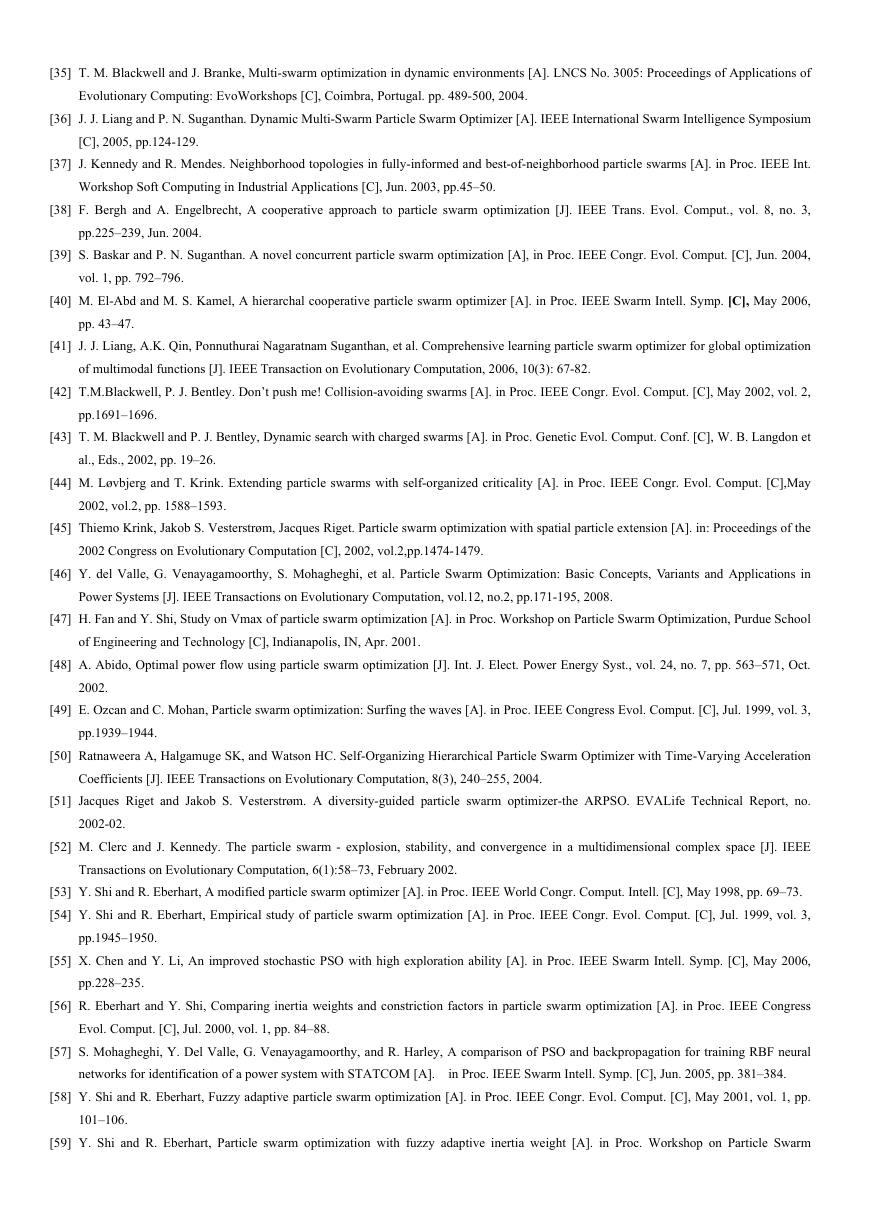








 2023年江西萍乡中考道德与法治真题及答案.doc
2023年江西萍乡中考道德与法治真题及答案.doc 2012年重庆南川中考生物真题及答案.doc
2012年重庆南川中考生物真题及答案.doc 2013年江西师范大学地理学综合及文艺理论基础考研真题.doc
2013年江西师范大学地理学综合及文艺理论基础考研真题.doc 2020年四川甘孜小升初语文真题及答案I卷.doc
2020年四川甘孜小升初语文真题及答案I卷.doc 2020年注册岩土工程师专业基础考试真题及答案.doc
2020年注册岩土工程师专业基础考试真题及答案.doc 2023-2024学年福建省厦门市九年级上学期数学月考试题及答案.doc
2023-2024学年福建省厦门市九年级上学期数学月考试题及答案.doc 2021-2022学年辽宁省沈阳市大东区九年级上学期语文期末试题及答案.doc
2021-2022学年辽宁省沈阳市大东区九年级上学期语文期末试题及答案.doc 2022-2023学年北京东城区初三第一学期物理期末试卷及答案.doc
2022-2023学年北京东城区初三第一学期物理期末试卷及答案.doc 2018上半年江西教师资格初中地理学科知识与教学能力真题及答案.doc
2018上半年江西教师资格初中地理学科知识与教学能力真题及答案.doc 2012年河北国家公务员申论考试真题及答案-省级.doc
2012年河北国家公务员申论考试真题及答案-省级.doc 2020-2021学年江苏省扬州市江都区邵樊片九年级上学期数学第一次质量检测试题及答案.doc
2020-2021学年江苏省扬州市江都区邵樊片九年级上学期数学第一次质量检测试题及答案.doc 2022下半年黑龙江教师资格证中学综合素质真题及答案.doc
2022下半年黑龙江教师资格证中学综合素质真题及答案.doc